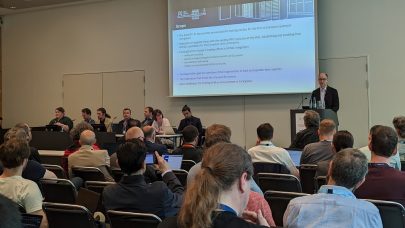
ISC BOF: Euro Quantum Community Tackles HPC-QC Integration, Broad User Access
May 23, 2023
Europe has clearly jumped into the global race to achieve practical quantum, though perhaps a step later (by a year or two) than the U.S. and China. Impressivel Read more…

MareNostrum 5 Installation Begins
February 27, 2023
Nearly four years ago, EuroHPC announced sites for eight new supercomputers as the nascent initiative debuted. MareNostrum 5, the third of the so-called “pre- Read more…

Europe to Dish out €270 Million to Build RISC-V Hardware and Software
December 16, 2022
The European Union will release €270 million in funds as it tries to attain technology independence by building chips based on the open RISC-V instruction set Read more…

Nvidia, Intel to Power Atos-Built MareNostrum 5 Supercomputer
June 16, 2022
The long-troubled, hotly anticipated MareNostrum 5 supercomputer finally has a vendor: Atos, which will be supplying a system that includes both Nvidia and Inte Read more…

Supercomputer Simulations Show How Paxlovid, Pfizer’s Covid Antiviral, Works
February 3, 2022
Just about a month ago, Pfizer scored its second huge win of the pandemic when the U.S. Food and Drug Administration issued another emergency use authorization Read more…

EuroHPC Restarts Procurement for MareNostrum5
December 21, 2021
Call it a New Year’s resolution: the EuroHPC Joint Undertaking—which serves as the concerted supercomputing play of the European Union—has issued a new ca Read more…

Amid a Canceled Tender, More Details of MareNostrum 5 (Finally) Emerge
June 28, 2021
Last October, the executive director of the EuroHPC JU – Anders Dam Jensen – said that with respect to MareNostrum 5 (the final pre-exascale EuroHPC system), “the tendering process was in its very final phase” and that “there would be announcements on that in the coming weeks.” Eight months later, the system’s status is still set to “it’s complicated.” Now, thanks to a brief presentation from... Read more…

Supercomputer Research Forecasts More Rain for Europe Under a Warmer Climate
June 4, 2021
As supercomputers become more powerful, the climate of the future is coming into sharper and sharper focus. In this case, it’s the climate of Europe and the N Read more…

- Click Here for More Headlines

Whitepaper
Transforming Industrial and Automotive Manufacturing
In this era, expansion in digital infrastructure capacity is inevitable. Parallel to this, climate change consciousness is also rising, making sustainability a mandatory part of the organization’s functioning. As computing workloads such as AI and HPC continue to surge, so does the energy consumption, posing environmental woes. IT departments within organizations have a crucial role in combating this challenge. They can significantly drive sustainable practices by influencing newer technologies and process adoption that aid in mitigating the effects of climate change.
While buying more sustainable IT solutions is an option, partnering with IT solutions providers, such and Lenovo and Intel, who are committed to sustainability and aiding customers in executing sustainability strategies is likely to be more impactful.
Learn how Lenovo and Intel, through their partnership, are strongly positioned to address this need with their innovations driving energy efficiency and environmental stewardship.
Download Now
Sponsored by Lenovo
Whitepaper
How Direct Liquid Cooling Improves Data Center Energy Efficiency
Data centers are experiencing increasing power consumption, space constraints and cooling demands due to the unprecedented computing power required by today’s chips and servers. HVAC cooling systems consume approximately 40% of a data center’s electricity. These systems traditionally use air conditioning, air handling and fans to cool the data center facility and IT equipment, ultimately resulting in high energy consumption and high carbon emissions. Data centers are moving to direct liquid cooled (DLC) systems to improve cooling efficiency thus lowering their PUE, operating expenses (OPEX) and carbon footprint.
This paper describes how CoolIT Systems (CoolIT) meets the need for improved energy efficiency in data centers and includes case studies that show how CoolIT’s DLC solutions improve energy efficiency, increase rack density, lower OPEX, and enable sustainability programs. CoolIT is the global market and innovation leader in scalable DLC solutions for the world’s most demanding computing environments. CoolIT’s end-to-end solutions meet the rising demand in cooling and the rising demand for energy efficiency.
Download Now
Sponsored by CoolIT
Advanced Scale Career Development & Workforce Enhancement Center
Featured Advanced Scale Jobs:
HPCwire Resource Library
HPCwire Product Showcase
© 2024 HPCwire. All Rights Reserved. A Tabor Communications Publication
HPCwire is a registered trademark of Tabor Communications, Inc. Use of this site is governed by our Terms of Use and Privacy Policy.
Reproduction in whole or in part in any form or medium without express written permission of Tabor Communications, Inc. is prohibited.
























